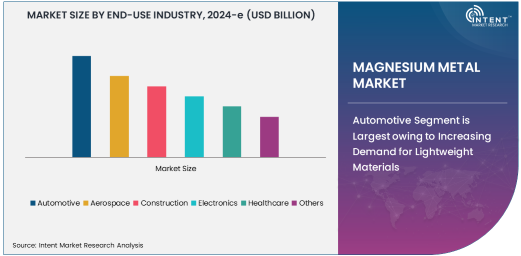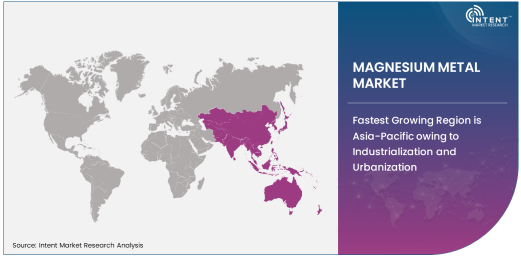As per Intent Market Research, the Magnesium Metal Market was valued at USD 4.6 Billion in 2024-e and will surpass USD 8.9 Billion by 2030; growing at a CAGR of 9.8% during 2025-2030.
The Magnesium Metal Market has witnessed substantial growth due to its diverse applications across various industries such as automotive, aerospace, construction, and electronics. As a lightweight and highly durable material, magnesium plays a crucial role in reducing weight and enhancing performance in numerous industrial applications. The ongoing advancements in magnesium production technologies and its rising adoption in sectors demanding sustainability and innovation are key drivers shaping the market's future trajectory.
Automotive Segment is Largest owing to Increasing Demand for Lightweight Materials
The automotive industry holds the largest share in the magnesium metal market due to its increasing use in lightweight components, which enhance fuel efficiency and reduce emissions. Magnesium alloys are extensively employed in automotive applications such as engine components, chassis parts, and wheels to achieve a balance between performance and weight reduction. The growing trend of electric vehicles further drives the demand for lightweight materials in the automotive sector.

Aerospace Segment is Fastest Growing due to High-Performance Requirements
The aerospace sector represents the fastest-growing segment in the magnesium metal market, driven by its high-strength-to-weight ratio and the need for lighter, more efficient components. Magnesium alloys are increasingly used in aircraft structures, including fuselage sections, landing gears, and engine components, to improve fuel efficiency and safety. This growth is further bolstered by innovations in aerospace manufacturing techniques and the continuous push for sustainable aviation solutions.
Construction Segment is Largest owing to Rising Demand for Structural Components
In the construction sector, magnesium metal is primarily utilized for structural components such as beams, columns, and façade panels. The segment’s growth is fueled by its resistance to corrosion and high durability, making it ideal for both residential and commercial projects. Additionally, the increasing focus on sustainable building materials further supports the adoption of magnesium-based solutions in construction.
Electronics Segment is Fastest Growing due to Demand for Heat Dissipation Solutions
The electronics segment is experiencing rapid growth due to the escalating demand for effective heat dissipation solutions. Magnesium alloys are used in electronic devices such as smartphones, laptops, and circuit boards to improve thermal management, ensuring optimal performance and longevity. The lightweight and excellent thermal conductivity properties of magnesium make it indispensable in the fast-paced, technology-driven electronics sector.
Healthcare Segment is Largest owing to Biocompatibility and Lightweight Properties
In the healthcare industry, magnesium metal is gaining traction due to its biocompatibility, which makes it ideal for implants and surgical instruments. The largest subsegment in healthcare focuses on lightweight orthopedic implants and biodegradable materials that enhance recovery processes. Furthermore, its anti-microbial properties further boost its adoption in medical devices and equipment.
Fastest Growing Region is Asia-Pacific owing to Industrialization and Urbanization
The Asia-Pacific region is emerging as the fastest-growing market for magnesium metal, driven by rapid industrialization and urbanization in countries like China, India, and Japan. The region’s extensive manufacturing base, coupled with increasing investments in automotive, aerospace, and construction sectors, has accelerated the demand for magnesium-based solutions. Moreover, favorable government policies and advancements in technology further fuel the region’s growth trajectory.

Leading Companies and Competitive Landscape
The magnesium metal market is highly competitive, with key players focusing on expanding production capacities and enhancing technological capabilities. Leading companies such as US Magnesium LLC, China Magnesium Corporation, and Magontec Limited are at the forefront of innovation, offering a wide range of magnesium products for various applications. These companies are increasingly focusing on sustainable manufacturing processes and strategic partnerships to strengthen their market presence. The competitive landscape is dynamic, with continuous mergers, acquisitions, and collaborations shaping industry standards and driving further growth.
Recent Developments:
- Alcoa Corporation announced a new magnesium alloy production line for automotive use.
- Magontec Limited acquired a leading magnesium manufacturing firm to expand its market share.
- China Southern Magnesium secured a major contract for aerospace-grade magnesium production.
- Treibacher Industrie AG launched a new eco-friendly magnesium alloy for the European market.
- POSCO Magnesium received regulatory approval for a new facility focused on sustainable magnesium production
List of Leading Companies:
- Alcoa Corporation
- Magnesium Elektron
- Us Magnesium LLC
- GEM Co., Ltd.
- China Magnesium Corporation
- Sundram Fasteners Limited
- Ningxia Magnesium Group
- Treibacher Industrie AG
- Shanxi Hongyuan Magnesium
- Fujian Yong’an Magnesium
- Magontec Limited
- Tianjin Magnesium International
- China Southern Magnesium
- POSCO Magnesium
- Guoxu Magnesium Industry Co., Ltd
Report Scope:
|
Report Features |
Description |
|
Market Size (2024-e) |
USD 4.6 Billion |
|
Forecasted Value (2030) |
USD 8.9 Billion |
|
CAGR (2025 – 2030) |
9.8% |
|
Base Year for Estimation |
2024-e |
|
Historic Year |
2023 |
|
Forecast Period |
2025 – 2030 |
|
Report Coverage |
Market Forecast, Market Dynamics, Competitive Landscape, Recent Developments |
|
Segments Covered |
Magnesium Metal Market By Product Type (Pure Magnesium, Magnesium Alloys), By Application (Lightweight Materials, Structural Components, Corrosion Resistance, Heat Dissipation), By End-User Industry (Automotive, Aerospace, Construction, Electronics, Healthcare), and By Region |
|
Regional Analysis |
North America (US, Canada, Mexico), Europe (Germany, France, UK, Italy, Spain, and Rest of Europe), Asia-Pacific (China, Japan, South Korea, Australia, India, and Rest of Asia-Pacific), Latin America (Brazil, Argentina, and Rest of Latin America), Middle East & Africa (Saudi Arabia, UAE, Rest of Middle East & Africa) |
|
Major Companies |
Alcoa Corporation, Magnesium Elektron, Us Magnesium LLC, GEM Co., Ltd., China Magnesium Corporation, Sundram Fasteners Limited, Ningxia Magnesium Group, Treibacher Industrie AG, Shanxi Hongyuan Magnesium, Fujian Yong’an Magnesium, Magontec Limited, Tianjin Magnesium International, China Southern Magnesium, POSCO Magnesium, Guoxu Magnesium Industry Co., Ltd |
|
Customization Scope |
Customization for segments, region/country-level will be provided. Moreover, additional customization can be done based on the requirements |
|
1. Introduction |
|
1.1. Market Definition |
|
1.2. Scope of the Study |
|
1.3. Research Assumptions |
|
1.4. Study Limitations |
|
2. Research Methodology |
|
2.1. Research Approach |
|
2.1.1. Top-Down Method |
|
2.1.2. Bottom-Up Method |
|
2.1.3. Factor Impact Analysis |
|
2.2. Insights & Data Collection Process |
|
2.2.1. Secondary Research |
|
2.2.2. Primary Research |
|
2.3. Data Mining Process |
|
2.3.1. Data Analysis |
|
2.3.2. Data Validation and Revalidation |
|
2.3.3. Data Triangulation |
|
3. Executive Summary |
|
3.1. Major Markets & Segments |
|
3.2. Highest Growing Regions and Respective Countries |
|
3.3. Impact of Growth Drivers & Inhibitors |
|
3.4. Regulatory Overview by Country |
|
4. Magnesium Oxide Market, by Type (Market Size & Forecast: USD Million, 2023 – 2030) |
|
4.1. Dead Burned Magnesium Oxide |
|
4.2. Fused Magnesium Oxide |
|
4.3. Light Burned Magnesium Oxide |
|
5. Magnesium Oxide Market, by Application (Market Size & Forecast: USD Million, 2023 – 2030) |
|
5.1. Agriculture |
|
5.2. Construction |
|
5.3. Chemicals |
|
5.4. Pharmaceuticals |
|
5.5. Ceramics |
|
6. Magnesium Oxide Market, by End-User Industry (Market Size & Forecast: USD Million, 2023 – 2030) |
|
6.1. Animal Feed |
|
6.2. Building Materials |
|
6.3. Fertilizers |
|
6.4. Pharmaceuticals |
|
6.5. Environmental |
|
6.6. Others |
|
7. Regional Analysis (Market Size & Forecast: USD Million, 2023 – 2030) |
|
7.1. Regional Overview |
|
7.2. North America |
|
7.2.1. Regional Trends & Growth Drivers |
|
7.2.2. Barriers & Challenges |
|
7.2.3. Opportunities |
|
7.2.4. Factor Impact Analysis |
|
7.2.5. Technology Trends |
|
7.2.6. North America Magnesium Oxide Market, by Type |
|
7.2.7. North America Magnesium Oxide Market, by Application |
|
7.2.8. North America Magnesium Oxide Market, by End-User Industry |
|
7.2.9. By Country |
|
7.2.9.1. US |
|
7.2.9.1.1. US Magnesium Oxide Market, by Type |
|
7.2.9.1.2. US Magnesium Oxide Market, by Application |
|
7.2.9.1.3. US Magnesium Oxide Market, by End-User Industry |
|
7.2.9.2. Canada |
|
7.2.9.3. Mexico |
|
*Similar segmentation will be provided for each region and country |
|
7.3. Europe |
|
7.4. Asia-Pacific |
|
7.5. Latin America |
|
7.6. Middle East & Africa |
|
8. Competitive Landscape |
|
8.1. Overview of the Key Players |
|
8.2. Competitive Ecosystem |
|
8.2.1. Level of Fragmentation |
|
8.2.2. Market Consolidation |
|
8.2.3. Product Innovation |
|
8.3. Company Share Analysis |
|
8.4. Company Benchmarking Matrix |
|
8.4.1. Strategic Overview |
|
8.4.2. Product Innovations |
|
8.5. Start-up Ecosystem |
|
8.6. Strategic Competitive Insights/ Customer Imperatives |
|
8.7. ESG Matrix/ Sustainability Matrix |
|
8.8. Manufacturing Network |
|
8.8.1. Locations |
|
8.8.2. Supply Chain and Logistics |
|
8.8.3. Product Flexibility/Customization |
|
8.8.4. Digital Transformation and Connectivity |
|
8.8.5. Environmental and Regulatory Compliance |
|
8.9. Technology Readiness Level Matrix |
|
8.10. Technology Maturity Curve |
|
8.11. Buying Criteria |
|
9. Company Profiles |
|
9.1. RHI Magnesita |
|
9.1.1. Company Overview |
|
9.1.2. Company Financials |
|
9.1.3. Product/Service Portfolio |
|
9.1.4. Recent Developments |
|
9.1.5. IMR Analysis |
|
*Similar information will be provided for other companies |
|
9.2. Magnezit Group |
|
9.3. Premier Magnesia |
|
9.4. Dolomite |
|
9.5. Ube Industries |
|
9.6. Yara International |
|
9.7. Martin Marietta |
|
9.8. Imerys |
|
9.9. Mississippi Lime |
|
9.10. Greer Lime Company |
|
9.11. Finnfjord |
|
9.12. Ferroglobe |
|
9.13. Nordkalk |
|
9.14. Magnezit Group |
|
9.15. Rhodia |
|
10. Appendix |
A comprehensive market research approach was employed to gather and analyze data on the Magnesium Metal Market. In the process, the analysis was also done to analyze the parent market and relevant adjacencies to measure the impact of them on the Magnesium Metal Market. The research methodology encompassed both secondary and primary research techniques, ensuring the accuracy and credibility of the findings.
.jpg)
Secondary Research
Secondary research involved a thorough review of pertinent industry reports, journals, articles, and publications. Additionally, annual reports, press releases, and investor presentations of industry players were scrutinized to gain insights into their market positioning and strategies.
Primary Research
Primary research involved conducting in-depth interviews with industry experts, stakeholders, and market participants across the E-Waste Management ecosystem. The primary research objectives included:
- Validating findings and assumptions derived from secondary research
- Gathering qualitative and quantitative data on market trends, drivers, and challenges
- Understanding the demand-side dynamics, encompassing end-users, component manufacturers, facility providers, and service providers
- Assessing the supply-side landscape, including technological advancements and recent developments
Market Size Assessment
A combination of top-down and bottom-up approaches was utilized to analyze the overall size of the Magnesium Metal Market. These methods were also employed to assess the size of various subsegments within the market. The market size assessment methodology encompassed the following steps:
- Identification of key industry players and relevant revenues through extensive secondary research
- Determination of the industry's supply chain and market size, in terms of value, through primary and secondary research processes
- Calculation of percentage shares, splits, and breakdowns using secondary sources and verification through primary sources
.jpg)
Data Triangulation
To ensure the accuracy and reliability of the market size, data triangulation was implemented. This involved cross-referencing data from various sources, including demand and supply side factors, market trends, and expert opinions. Additionally, top-down and bottom-up approaches were employed to validate the market size assessment.
NA
